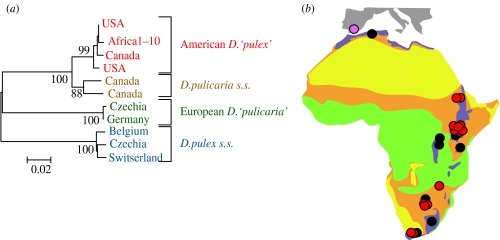Figure 3.
Geographical distribution of the invading American D. pulex clone in Africa. (a) Genetic tree obtained from an ND5 gene fragment showing the relationship of contemporary African D. pulex populations to other members of the D. pulex complex. Although morphologically indistinguishable, American and Old World D. pulex are genetically two distinct species (Colbourne et al. 1998). Scale bar indicates K2P genetic distance. Numbers at nodes indicate bootstrap support. (b) Comparison of the known distribution of the invading clone (red circles) with historical records of D. pulex in Africa (black circles). The pink circle shows the record of the same American 12S haplotype in Spain. Green: tropical forest; yellow: (semi)desert; lilac: temperate and mountain forest/grassland; orange: steppe and savannah.

